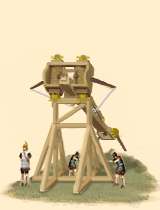Talantiaioi Lithoboloi (1 talent Stone Projectors)
 |
Weapons | Defence | Mental | ||||||
|---|---|---|---|---|---|---|---|---|---|
| Primary | Secondary | Armour: | 1 | Morale: | 7 | ||||
| Type: | knife | none | Shield: | 0 | Discipline: | normal | |||
| Attack: | 8 | 60 | Skill: | 7 | Training: | untrained | |||
| Charge: | 2 | 2 | Recruitment | Other | |||||
| Lethality: | 0.04 | 1 | Soldiers: | 15 | Hit Points: | 1 | |||
| Range: | 0 | 160 | Cost: | 30000 | Mass: | 0.85 | |||
| Ammo: | 0 | 30 | Upkeep: | 4500 | |||||
| Turns: | 1 | ||||||||

Mural artillery designed to take down ANY wall, given enough time. Talantiaioi Lithoboloi form a battery of large One-talent Stone Projectors, immobile and very expensive. But they give you the ability to break down a section of the enemy wall with greater leisure - without losing a drop of blood.
Mural artillery designed to take down ANY wall, given enough time. Talantiaioi Lithoboloi form a battery of large One-talent Stone Projectors, immobile and very expensive. But they give you the ability to break down a section of the enemy wall with greater leisure - without losing a drop of blood.
The Stone Projectors, like any artillery, is a Greek invention dating to the time of Tyrannos Dionysios of Syrakousai (read more about this in the unit info of the katapeltai). After the spectacular premiere of the flexion-based "Gastraphete" (bellybow) at Motya, the concept of the "Katapeltikon" had come to stay. The father of Megas Alexandros, Phillipos of Makedonia, may have been the first to foment the invention of the torsion-based Katapeltai - replacing the older flexion-design. Torsion was first used to power Arrow Projectors, but the tremendous potential could not be ignored for long, and eventually large stone throwing machines were made. The Greeks found what they thought was the perfect formula and ratio between the diameter of the torsion-washer and its height, distance between the two - though they didn't yet know that the Romans would push this envelope in the time of Vitruvius around 70 BC. The Greeks came to this correct aspect-ratio using trial and error. Romans had the leisure of simply building upon something the Greeks had worked hard on. The largest stone projector ever devised was the Three-talent Stone Projectors used in the gigantic 45 meter tall "Helepolis" siegetower built by Epimachos the Athenian on the order of Demetrios "Poliorketes" (the Besieger) and used at the siege of Rhodos in 305 BC. Each of these "Tritalantoi Lithoboloi" fired massive stones weighing 80 kilograms each. There were three of these Stone Projectors in the first floor - there were smaller ones for each story the higher you went. At the top, there was only arrow artillery to provide covering fire. Athenaios remarked that the tower could withstand blows from a Three-talent Stone Projector. The point of the comment surely is that it was the heaviest blow Athenaios could imagine, although the rather more technically-minded Philon held the opinion that the One-talent machine was far more to be feared, in due part to the fact that it was cheaper and easier to maintain, harder to wear out, and more importantly that it had a higher rate of fire and a different trajectory.